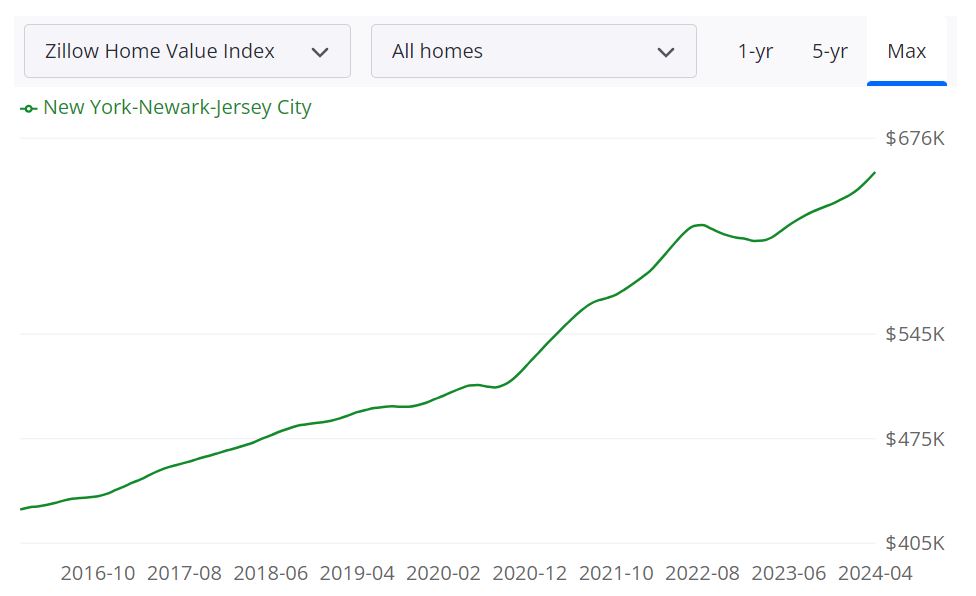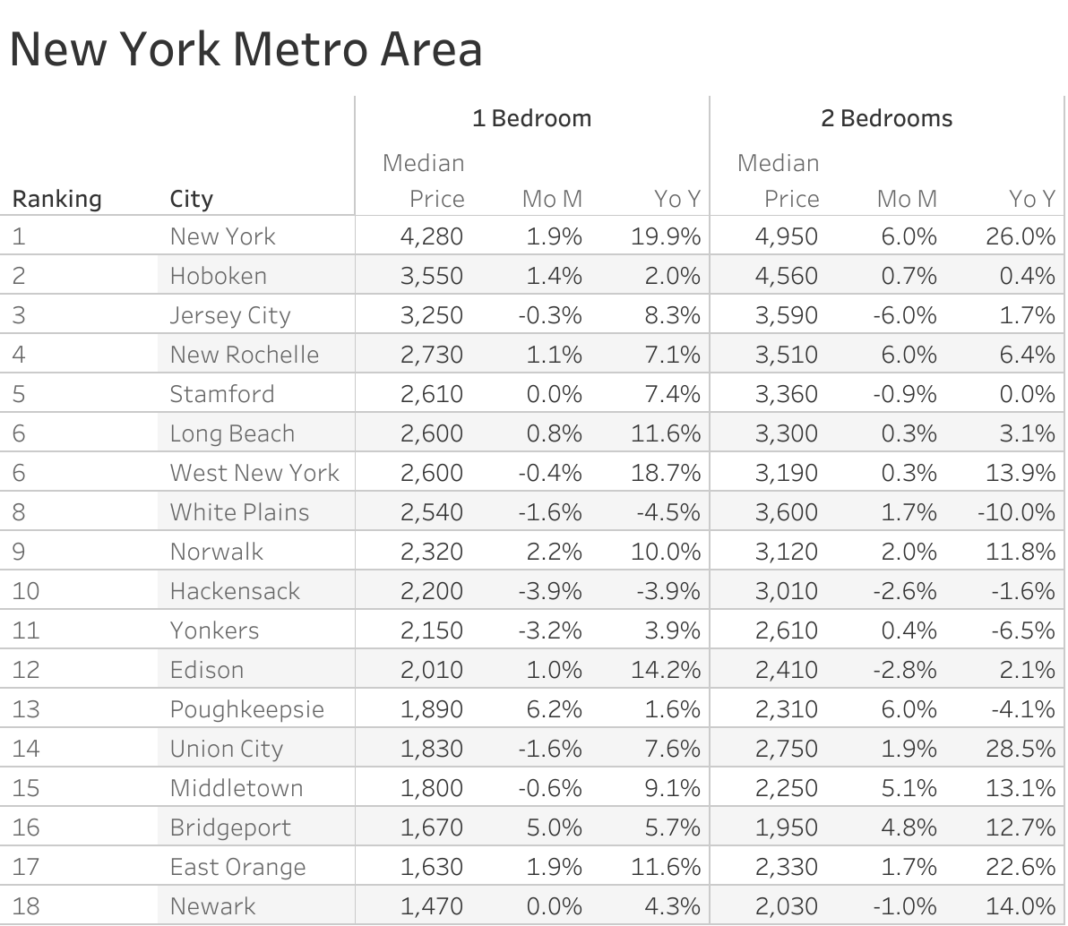

New York City boasts one of the most recognizable housing markets in the world. Fueled by a vibrant economy and iconic status, it consistently attracts a wave of residents seeking a piece of the Big Apple dream. However, before diving into this dynamic market, understanding current trends and price points is crucial.
This year is shaping up to be a pivotal moment in real estate, marked by evolving demand, shifting supply dynamics, and changing pricing patterns. With the impending impact of fluctuating mortgage rates, the NYC housing market is poised for what could be a transformative year.
More options are available as mortgage rates decline and new listings rise.
The middle third of homes by price is moving quickly, indicating stronger demand in this category.
For the first time since 2019, new condo listings are outpacing co-ops, encouraging sellers to enter the market.
The market for entry-level homes is heating up, showcasing increased buyer interest.
The home sales data from StreetEasy shows a notable uptick in activity this year. In July alone, 1,984 homes entered contract, a significant 12.5% increase from the previous year. As a resident of New York City, it has been fascinating to see the landscape shift with more buyers showing intent to purchase despite historically high mortgage rates.
A keen observation from my experience is that the market is particularly vibrant for properties in the middle price segment, which is seeing a faster turnover. Homes priced between $750,000 and $1.7 million spent an average of 61 days on the market, down from 71 days last July.
The rapid movement in the mid-priced homes category illustrates a resurgence of buyer confidence as more potential homeowners feel the pinch of rising rental costs and view purchasing as a favorable long-term investment.
As of the latest data, the median asking price in New York City remains at $1.1 million, a figure mirrored from earlier this year, suggesting that although prices have stabilized at high levels, the peak might not be far off. It is crucial to look at these figures in the context of the broader economic environment.
With the Federal Reserve expected to cut interest rates in September 2024, mortgage rates are gradually decreasing, making home affordability a little better for buyers. However, the typical home sales are still pushing against an average median price point, which can feel daunting.
Interestingly, condo prices in Brooklyn are notably on the rise, averaging nearly $1.1 million—a 9.7% increase from last year. This continues to reinforce the notion that as neighborhoods develop and offerings diversify, some areas are becoming prime targets for higher returns. One can’t help but reflect on the shifting preferences that accompany these price trends; buyers are now leaning more towards condos over co-ops due to greater flexibility in financing options.
New condos are appearing at a robust rate, signaling an important shift in inventory. For the first time since 2019, new condo listings have overtaken new co-op listings, with a remarkable increase of 5.5% year-over-year. With 3,694 condos listed between May and July, it’s clear that sellers are responding to market demands—particularly in Manhattan and Brooklyn.
From my perspective, this change is not just about numbers; it's reflective of a broader attitude towards ownership in NYC. Many buyers are now willing to consider condos over co-ops, largely due to their more lenient financing arrangements and lack of rigid application processes. This trend is particularly relevant for first-time buyers who often face hurdles in traditional co-op applications.
However, inventory is not uniform across the city. The overall housing stock remains tight despite a surge in new listings. As of July, there were 17,618 homes on the market, just a slight decline from last year, indicating that while sellers are more willing to list their homes, the inventory levels still create a competitive environment.
Analyzing the various market trends gives great insight into what to expect as we head deeper into the year. The rise in new listings combined with a decline in total inventory paints a picture of a market that is in transition. Homes in the lower third price range (under $750,000) are also witnessing increased interest, with new contracts rising 13.5% year-over-year, which indicates a growing pool of buyers looking to enter the market.
One of the more compelling aspects of the current market dynamics is the increasing prevalence of price cuts. Data indicates that 10.4% of homes on the market reduced their asking prices in July, compared to 10.1% the previous year. This suggests that while the demand remains strong, sellers might be reassessing their expectations, paving the way for more balanced negotiations as inventory rises.
Particular neighborhoods are driving the competitive nature of the market. For example, Queens has become more competitive for starter homes, with 402 new contracts being signed despite a decrease in new listings. As an observer of local trends, I find it noteworthy how neighborhoods like Jackson Heights and Astoria are emerging as hotspots due to their desirable features and more affordable pricing.
As of July 2024, the New York housing market is showing promising signs of recovery and growth. The latest report from the New York State Association of REALTORS® highlights a number of key metrics indicating positive trends across the Empire State.
In July, closed home sales experienced a 3.5% increase, rising from 9,584 units in 2023 to 9,923 homes in 2024. This increase is a clear indication that buyer demand is returning as market conditions improve. Additionally, pending sales also saw a notable uptick, with figures climbing from 9,849 homes in July 2023 to 10,618 homes in 2024.
This marks an impressive 7.8% increase, suggesting that more buyers are actively engaging in the market, reflecting a renewed confidence that is essential for a healthy real estate environment.
Moreover, new listings of homes showed a slight increase of 0.5%, moving from 13,260 listings in 2023 to 13,322 homes in July 2024. While this growth may seem modest, it is significant given the context of rising demand and stabilizing mortgage rates.
Mortgage interest rates have continued to decline, further incentivizing potential buyers. In July, rates fell to below seven percent, with Freddie Mac reporting that the average interest rate on a 30-year fixed-rate mortgage was 6.84%, down eight-tenths of a percent from previous months. These lower rates are crucial for improving affordability, making homeownership more accessible for many prospective buyers throughout the state.
Despite the increase in sales and listings, the inventory of homes available for sale in New York has been decreasing. In July 2023, there were 29,642 homes available, while that figure dropped to 28,045 units in July 2024—a 5.4% decline in year-over-year inventory. This shrinking inventory highlights the challenges potential homebuyers may face when trying to secure a home, even as overall sales activity picks up.
Another critical indicator of the market’s health is the median sales price, which rose by 8.7% in July. The median price climbed from $400,000 last year to $435,000 this year. This increase suggests that as inventory remains tight and buyer interest grows, sellers are capitalizing on the demand by setting higher asking prices.
The New York City metropolitan area, including Newark and Jersey City, remains a hot property market, with home values averaging a cool $654,172 (Zillow) – that's a healthy jump of 7.2% compared to last year.
Houses are also flying off the shelves, typically going into pending status within 23 days. But is this a gold rush destined to continue, or are there storm clouds gathering on the horizon? Let's dive into the data and see what the future holds for New York real estate.
The forecast of a 2.2% dip by April 2025 shouldn't send chills down the spines of long-term investors. It's important to remember that real estate markets are cyclical, and periods of rapid growth are naturally followed by periods of stabilization or correction. This is a healthy pattern that allows the market to catch its breath and prevents unsustainable bubbles from forming.
While there may be a slight price adjustment in the coming year, New York City remains a desirable and dynamic place to live, and property values are likely to continue trending upwards over the long term. Savvy investors will use this potential cool-down as an opportunity to enter the market at a more attractive price point.
Here's a snapshot of the current market to help you get a grip on where things stand:
As depicted in this graph of Zillow, home values have increased year-over-year. This upward trend is expected to persist, with forecasts indicating continued growth over the next year.

The New York housing market presents a picture of moderate and steady growth across various regions. While the data provided doesn't include figures for May 31st, 2024, it offers projections for July 31st, 2024, and April 30th, 2025. Let's delve into what these forecasts suggest for potential buyers and sellers in different parts of the state.
Across upstate New York, including areas like Kingston, Rochester, Syracuse, Jamestown, Olean, and Hudson, forecasts indicate a trend of consistent growth. These regions are expected to see price increases ranging from 0.9% to 2.1% by July 31st, 2024, with projections for continued growth reaching 1.7% to 3.2% by April 30th, 2025. This suggests a stable market with consistent appreciation for sellers and potentially competitive conditions for buyers.
Regions in central and western New York, such as Amsterdam, Seneca Falls, Buffalo, Batavia, Auburn, Gloversville, Utica, and Binghamton, are also forecast for moderate growth. Price increases are expected to fall within a range of 1.2% to 2.1% by July 31st, 2024, with projections for a slower but steady increase reaching 0.9% to 1.8% by April 30th, 2025. These areas are likely to see a balanced market with opportunities for both buyers and sellers.
While the forecast suggests a generally positive outlook for the New York housing market, some external factors can influence local conditions. Here are some key considerations:
| RegionName | BaseDate | 30-04-2025 |
|---|---|---|
| Kingston, NY | 30-04-2024 | 3.2% |
| Rochester, NY | 30-04-2024 | 3.1% |
| Syracuse, NY | 30-04-2024 | 2.8% |
| Jamestown, NY | 30-04-2024 | 2.7% |
| Olean, NY | 30-04-2024 | 2.1% |
| Hudson, NY | 30-04-2024 | 2% |
| Amsterdam, NY | 30-04-2024 | 1.7% |
| Seneca Falls, NY | 30-04-2024 | 1.7% |
| Buffalo, NY | 30-04-2024 | 1.4% |
| Batavia, NY | 30-04-2024 | 1.3% |
| Auburn, NY | 30-04-2024 | 1.2% |
| Gloversville, NY | 30-04-2024 | 1% |
| Utica, NY | 30-04-2024 | 0.9% |
| Binghamton, NY | 30-04-2024 | 0.5% |
| Oneonta, NY | 30-04-2024 | 0.2% |
This table presents the forecasted trends for April 2025 in various regions across New York State, providing insights into the anticipated housing market conditions.
Overall, the New York housing market offers opportunities for both buyers and sellers seeking a stable and growing market. By understanding regional variations, the impact of external factors, and local market dynamics, informed decisions can be made in this dynamic landscape.
Experts predict a dramatic crash in New York's housing market is unlikely in 2024. Two key factors underpin this forecast:
However, a cool-down from the recent seller's market frenzy is likely. Here's a breakdown of what to expect:
Beyond the immediate forecast, here are some additional factors that could influence the New York housing market:
Overall, while a crash is improbable, the New York housing market is likely to transition into a more balanced state. This could benefit buyers who have been priced out of the market in recent years. However, sellers may need to adjust their expectations regarding sale prices and timelines. It's important to stay informed about the latest market trends and economic data to make informed decisions about buying or selling a home in New York.
The Zumper New York City Metro Area Report analyzed active listings across the metro cities to show the most and least expensive cities and cities with the fastest growing rents. The New York one-bedroom median rent was $2,430 last month. New York City was the most expensive market with one-bedrooms priced at $4,280 whereas Newark was the most affordable city with rent priced at $1,470.
Here are the places where it makes sense to invest in rental properties in the New York City Metro Area. These are the places where the demand for rentals is growing strong in 2024.
The Fastest Growing Cities For Rents in New York City Metro Area (Y/Y%)
The Fastest Growing Cities For Rents in New York City Metro Area (M/M%)

Buffalo real estate market
The Buffalo real estate investment offers a surprisingly good deal with low prices and relatively high rental rates. The Buffalo real estate market is dominated by older homes. A majority of homes in the Buffalo housing market were built before World War 2. Interestingly, this also means that many small apartment buildings are designed to serve a population that rented small units close to their jobs.
For example, roughly a third of homes are single-family detached homes, while almost half take the form of small apartment buildings. This creates an excellent opportunity for those in the market for Buffalo rental properties. You could buy a small apartment building with multiple tenants for the cost of a single rental property in a more expensive New York real estate market.
Syracuse real estate market
Syracuse's real estate market offers cheaper property with a higher return on investment and a less hostile legal climate. It is one of the better choices if you want to invest in New York state. Another issue that factors into the equation is the job market. Lots of cities have a great quality of life but almost no one can afford to live there.
The Syracuse housing market ranked 6.3 out of 10 for its job market. That’s better than rural and much of upstate New York. And it is why there is a slow trickle of people moving in to replace those who leave. That’s why the Syracuse real estate market has a net migration of 5 or a stable population. This is in sharp contrast to the depopulation seen in most Rust Belt cities. It also means Syracuse's real estate investment properties will hold their value for the foreseeable future if they don’t appreciate it.
Albany real estate market
Albany is a steadily appreciating real estate market. While it isn’t as famous or hot as NYC, it offers an affordable entry point and a massive pool of perpetual renters. Though it may not be somewhere you want to live, many locals are choosing to stay and make their homes here. And that will continue to drive demand for Albany real estate investment properties as long as they are priced right.
Rochester real estate market
You can also consider Rochester. The Rochester real estate market is stable, offering slow appreciation, affordable properties to outsiders, and good returns. It has strong, long-term potential that is only buoyed if NYC collapses. And this is one of the reasons why being everything the Big Apple isn’t is in your favor.
The Rochester real estate market enjoys a healthy population profile. Roughly a quarter of the population consists of children, and many are likely to remain due to the healthy job market. It also means that the Rochester housing market won’t crash if the job market weakens the way San Francisco collapses whenever the tech bubble bursts. Others choose to remain here because of the low cost of living.